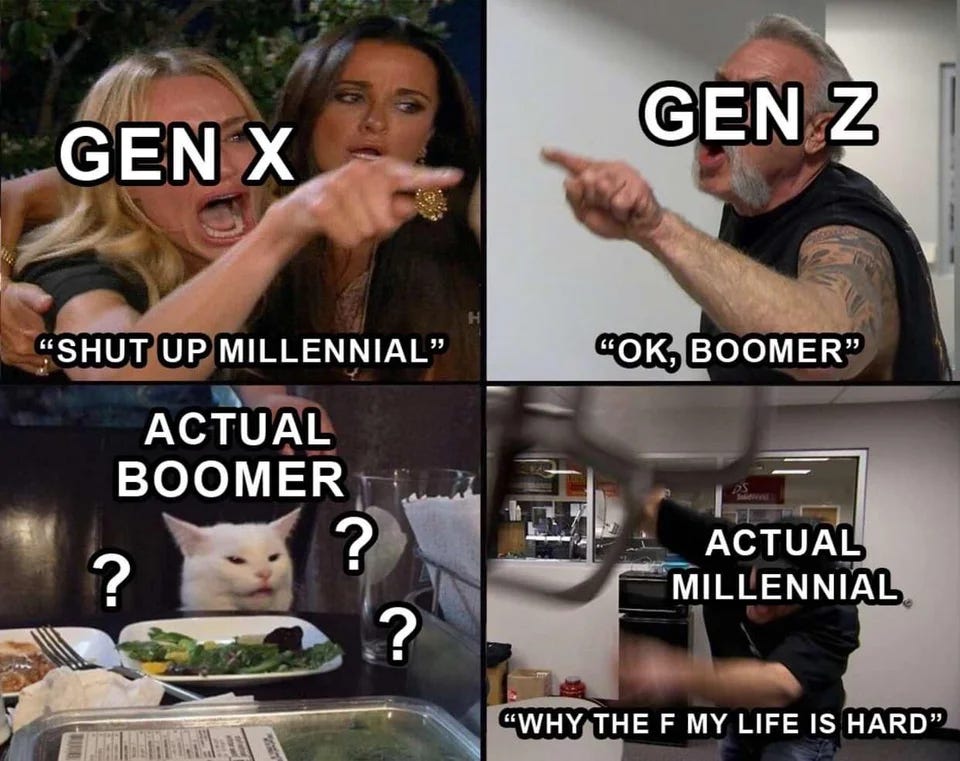Random Detour - The Interpretation of Memes
Please open your manuscripts to Woman Yelling at Cat 3:16
Some of you may have seen this meme going around. It really speaks to me as an elder millennial (who didn’t have a computer until middle school), whenever I hear “millennial” being used as a lazy slur for vapid social media obsessed young people, and I’m like… um… actual millennials are pushing forty, with kids, mortgages, and mountains of student debt (except those with Asian parents 🙏🏻🙏🏻🙏🏻🙇🏻♂️).
But then I got to thinking… it actually takes a *LOT* to really understand this meme. Two thousand years from now, if you saw this with zero context or background knowledge, how much would actually make any sense?
It will still be obvious that there is some intense arguing happening. You will be able to look up (via your neural implant) that Boomers, Gen X, Millennials, and Gen Z were monikers ascribed to certain generational cohorts of 20th-21st century Americans. But why is there a cat and what is even happening in the bottom right panel? (btw some of you here in 2021 might be just as confused)
First, understanding this meme requires understanding the cultural dynamics of 21st century American society. While I’m sure there will be books and articles on this, the message here really depends on a lived experience to fully appreciate. This meme is primarily targeted at an audience that will just “get it” immediately. While it can be academically dissected and explained, it won’t land with the same impact as with the original audience.
Moving on from the message to the medium, it gets even more complicated. This is actually a mashup of two memes: Woman Yelling at Cat and American Chopper Argument. Woman Yelling at Cat is itself a mashup of a scene from Real Housewives of Beverly Hills (RHOBH) plus an entirely unrelated picture of an internet cat named Smudge eating a salad. The other two panels come from a five-panel series of screenshots from an episode of American Chopper. The bottom right panel is blurry but any distinguished internet scholar would instantly recognize it as Paul Teutul Jr. throwing an office chair. Eagle-eyed viewers may also notice that Smudge has been horizontally flipped for better visual balance.
At a surface level, all you really need to understand here is that a bunch of people/groups are arguing. But to actually fully appreciate the genius and nuance, requires familiarity not only with the two memes, but also their evolution and dynamics in 21st century American internet culture. And even people who know ALL these things may still get some details mixed up, for example mistakenly believing Smudge was actually on RHOBH. I mean… come on who can keep track… that meme is ancient (2019).
OK, is there a point here? It’s that communication, whether it’s an epistle from Paul or a silly meme, is inextricably filtered through the lens of culture. And culture is preposterously complicated. Doing a decontextualized plain text interpretation will probably get you 80% there 80% of the time, but comes with a high risk of error or incompleteness. Proponents of “common sense” biblical interpretation will argue that God has made Scripture uniquely possible for anyone to understand without cultural context (i.e. just read the passage and say what it means to you). And that’s probably true in many cases, but will hit a wall in other cases.
One illuminating example is Rev 3:15-16, which lambasts the church of Laodicea for being neither cold or hot, but lukewarm. In 21st century America, this can be misunderstood to mean it’s better to be spiritually “on fire” or decisively cold, instead of just being wishy-washy. However, the original audience would have understood that the town of Laodicea was connected via aqueduct to two other towns, one with a hot thermal spring and another with fresh cool water. By the time the two waters got to Laodicea, they had both lost their unique and valuable properties. The original manuscript didn’t come with a footnote, and we had to rely on extra-biblical sources to properly interpret this passage.
In other cases, there are certain words that appear only one or few times (hapax legomena) in the Bible or even among all known texts. For example the Greek word epiousios (ἐπιούσιος) in the Lord’s Prayer is traditionally translated as “daily” in “our daily bread”. But we literally have no idea what that word actually means, except that it almost certainly does NOT mean daily. And Christians were already confused about this word as early as the 4th century. Another example is the words arsenokoitai and malakoi, which have been traditionally understood to refer to same sex relations. But we are largely speculating about their exact meaning, and mostly in the dark about the specific context of how the 1st century audience would have understood it, especially relative to our contemporary society. So much hinges on it, and we may never know for sure. Thankfully, vital archives like knowyourmeme.com will ensure that our precious memes will never meet that same fate.
I’m not saying interpreting the Bible is the same as interpreting memes. I’m also not saying that the enjoyment of memes and Bible passages should be restricted only for holders of advanced degrees. But I do think both require an appreciation of how culture shapes communication, a ton of research and scholarship, and a healthy dose of humility. But when it does all come together, whether it’s a chuckle while scrolling through facebook or life-changing wisdom, it’s a beautiful thing.
Hat tip to the Reply All podcast’s recurring segment Yes/Yes/No, which is always entertaining and informative.



